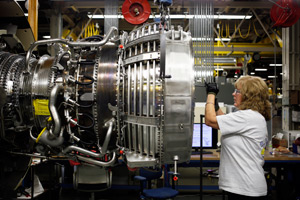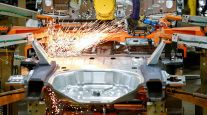Manufacturing Grows in November

Manufacturing in the U.S. expanded in November at a faster pace than projected, signaling the world’s largest economy is rising above a global slowdown.
The Institute for Supply Management’s factory index was little changed at 58.7 last month, the second-strongest level since April 2011, compared with 59 in October, the Tempe, Arizona-based group reported. It exceeded the median forecast of 80 economists surveyed by Bloomberg News and readings greater than 50 indicate growth.
Orders over the past four months have been the strongest in a decade as growing demand from American consumers makes up for any letdown among foreign customers. Continued progress in the labor market and the plunge in gasoline prices may give Americans an even greater ability to spend in coming months, supporting manufacturing as the year draws to a close.
“Whatever is happening abroad, this sector seems to be shrugging it off,” said Guy Berger, a U.S. economist at RBS Securities Inc. in Stamford, Connecticut, who projected a reading of 58.5. “There’s always the worry that the weakness in growth abroad eventually starts filtering into it but right now it’s not really obvious.”
The median estimate in a Bloomberg survey of economists called for a decline to 58. Projections ranged from 54.5 to 61. Manufacturing accounts for about 12% of the economy.
The U.S. ISM’s orders index climbed to 66 from 65.8 in October. The 64.6 average over the past four months is the highest for a similar period since early 2004.
Even exports showed improvement, with the gauge advancing to 55 from 51.5 in October.
Factories are struggling to keep up with demand as the index of bookings waiting to be filled rose to 55, the highest since April, from 53.
Some of the increase in backlogs may be due to inclement weather last month that could have prevented companies from obtaining needed parts. ISM’s supplier deliveries gauge increased to the highest level since February, indicating factories were experiencing more delays in getting materials.
The group’s production gauge barely budged from a 10-year high, decreasing to 64.4 in November from 64.8 the month before.
The measure of factory employment decreased to 54.9 from 55.5 in October.
Lower raw-material costs are another boon for manufacturing. ISM’s prices paid index fell to 44.5, signaling expenses dropped for the first time since July 2013 and by the most since July 2012.
One potentially dark cloud in the report was that factories’ clients reported they had about enough goods on hand, suggesting bookings may not pick up much more. The customer inventory index rose to 50, the break-even point between having too much and too little stock. That was its highest reading in three years.
Gross domestic product grew at a 3.9% annualized pace in the third quarter following a 4.6 rate in the prior period, marking the strongest six months of growth in more than a decade, according to figures from the Commerce Department.
Consumer spending, which accounts for about 70% of the economy, grew at a 2.2% annualized rate in the third quarter up from a previously estimated 1.8%. The improvement was spread across durable and non-durable goods, including recreational vehicles and restaurant meals.
Business investment in new equipment climbed at a 10.7% annualized rate last quarter, revised up from 7.2%, last week’s report showed.




